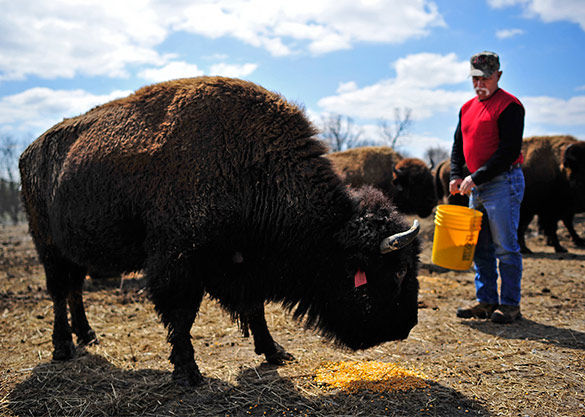Bison roam the hills of southern Illinois
April 9, 2014
Early afternoon on a warm day in southern Illinois, there is not a cloud in the sky. A man maneuvers his four-wheel off-road utility vehicle into the middle of a wide pasture and stops. As he steps out of the vehicle, his boots dig into the mud as he walks to the truck bed to retrieve several buckets of corn.
Moving in a circle, he pours the corn into small piles around the vehicle and in a deep, bellowing voice yells, “Buffalo!” His voice travels over the field, attracting the attention of a herd of large animals in the distance and in a matter of seconds, curious bison surround him.
The man is Clifton Howell. He and his family, including his children Anthony, Chris, Richard and Margaret, own and operate Bison Bluff Farm. Located off of Bethel Church Road east of Cobden, the farm is on a 1,100-acre plot of land nestled into the rolling hills of southern Illinois.
Advertisement
Howell said he began buying the land piece-by-piece starting with 100-acres around 22 years ago.
Howell said the farm provides the perfect area for bison to do what they do best: roam. Howell said the bison cover roughly 600 acres each day.
Bison herds run like most large groups of mammals. Usually there is one male who asserts authority on the farm, Howell said.
“A bull is considered mature at five years old,” he said. “At around seven to nine, he no longer is the dominant bull. My herd, I run 10 bulls and one bull does 98 to 99 percent of all the breeding.”
Howell, who owns and operates a construction company full-time, said raising bison is not about the money.
“There’s money in everything you do,” he said. “It costs you money for everything, you try and turn a profit and make money with something. I do this for a hobby.”
The farm is home to approximately 350 bison. The number varies from year to year depending on how many calves are born. Around six bison are sent out for butchering once a month, Howell said.
Advertisement*
Bison meat is lean and designated as a healthy alternative to other red meats. According to the United States Department of Agriculture, bison meat contains only 2.42 grams of fat per 100 gram serving while choice beef contains 18.54 grams of fat per 100 grams. Choice beef contains 283 calories per 100 gram serving while bison meat contains only 143 calories.
Howell feeds the bison hay and grass for most of their lives. No hormones or chemicals are added to their diet.
“They get all the natural hay they want,” he said. “We bail around 900 round bails each year. During the wintertime, my average consumption is about four and a half round bails a day.”
Howell said each round bail of hay weighs around 1,500 lbs.
Before the animals are butchered, they are sent to a feedlot where they are put on a corn diet. Howell said the flavor of meat is a lot better if the bison have been corn fed instead of living their entire lives on just grass.
The Neighborhood Co-op Grocery Store in the Murdale Shopping Center is one of the local buyers of Bison Bluff Farm meat.
Wade Chambliss of Murphysboro, the co-op’s meat buyer, said stocking the shelves with bison meat is great because not a lot of people are doing it and buying from a local farmer is good for the community.
“Everything they do is done local,” Chambliss said. “Their bison are raised here, they are slaughtered here, and everything is processed and packaged and brought straight here. To us, that is great because that means all of that money goes directly back into our community, which is what the co-op is all about.”
The bison population was nearly destroyed by human intervention in the 19th century,
At one time, there were an estimated 40 to 60 million bison roaming the lands of North America, according to the National Bison Association.
By the late 1800s, after years of over-hunting for furs, tongues, bones and meat, the population of the North American bison numbered less than 1,000 before humans began efforts to preserve and repopulate the nearly extinct species.
According to the latest agricultural census taken by the USDA, in 2007 there were 198,234 bison residing on private ranches and farms in the United States.
The same census counted 4,499 private ranches and farms like Howell’s raising bison. The National Bison Association estimates the current total North American herd size at around 450,000 bison.
Because of farmers like Howell and his family, the population has been increasing over the last 100 years.
Advertisement







